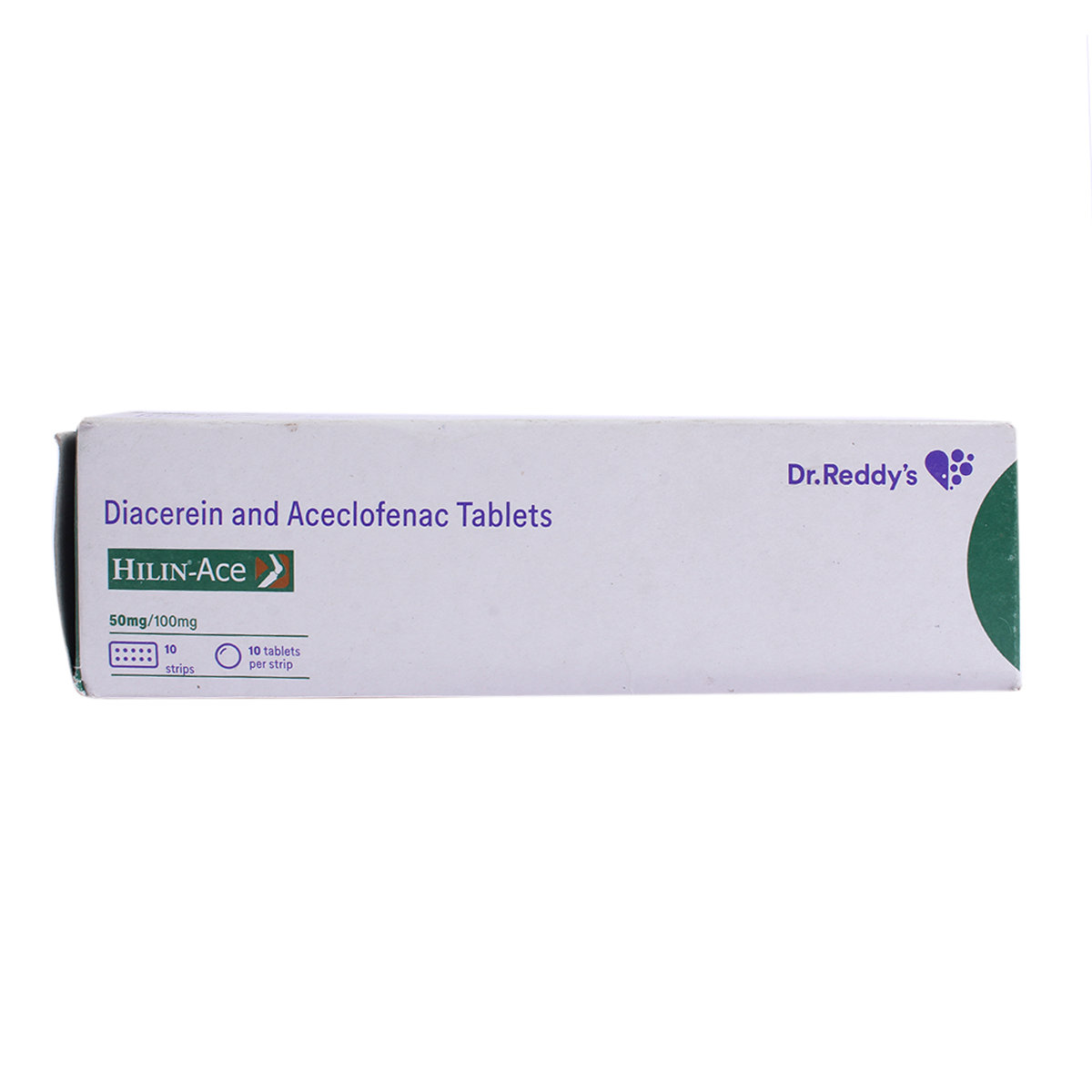Dycerin A Tablet 10's
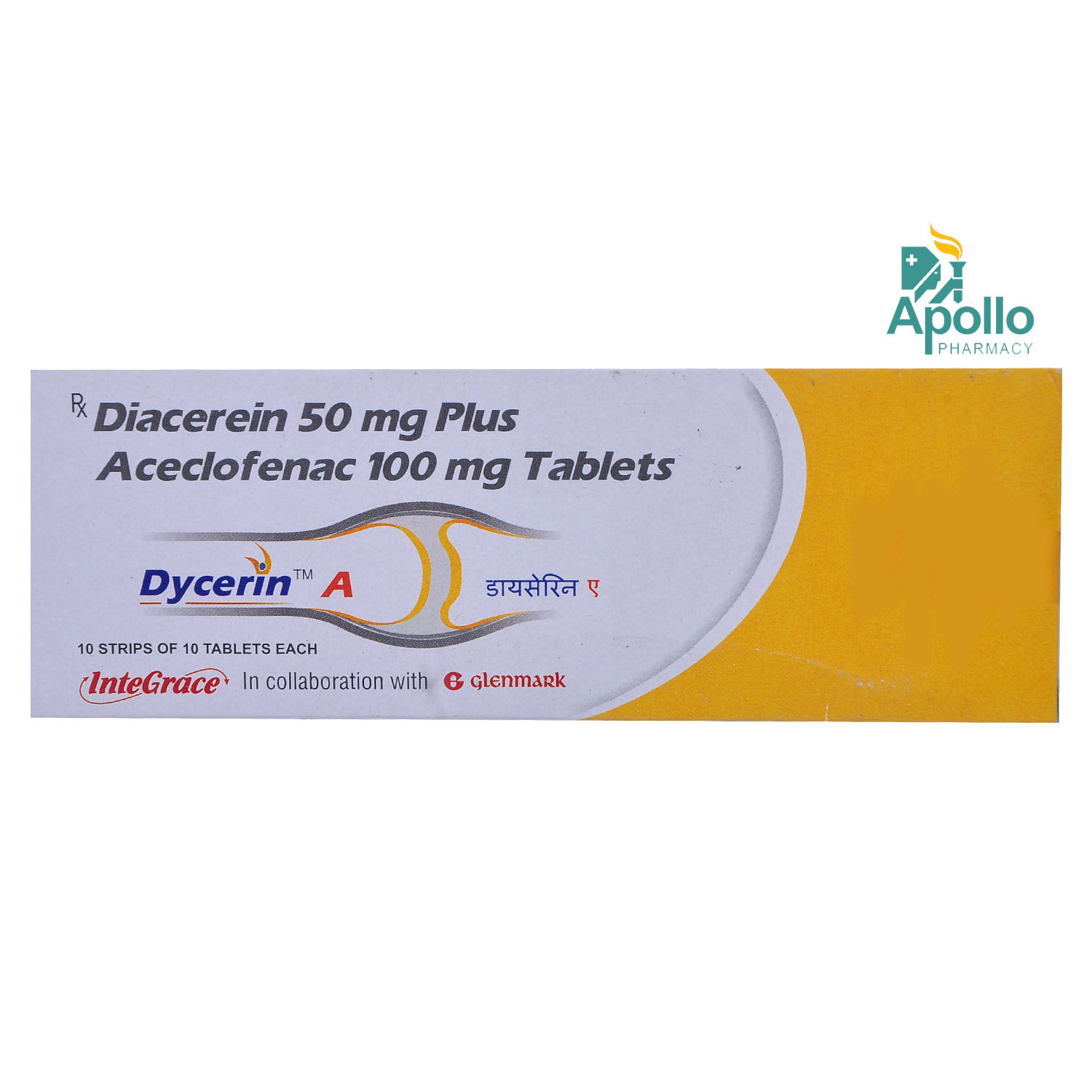
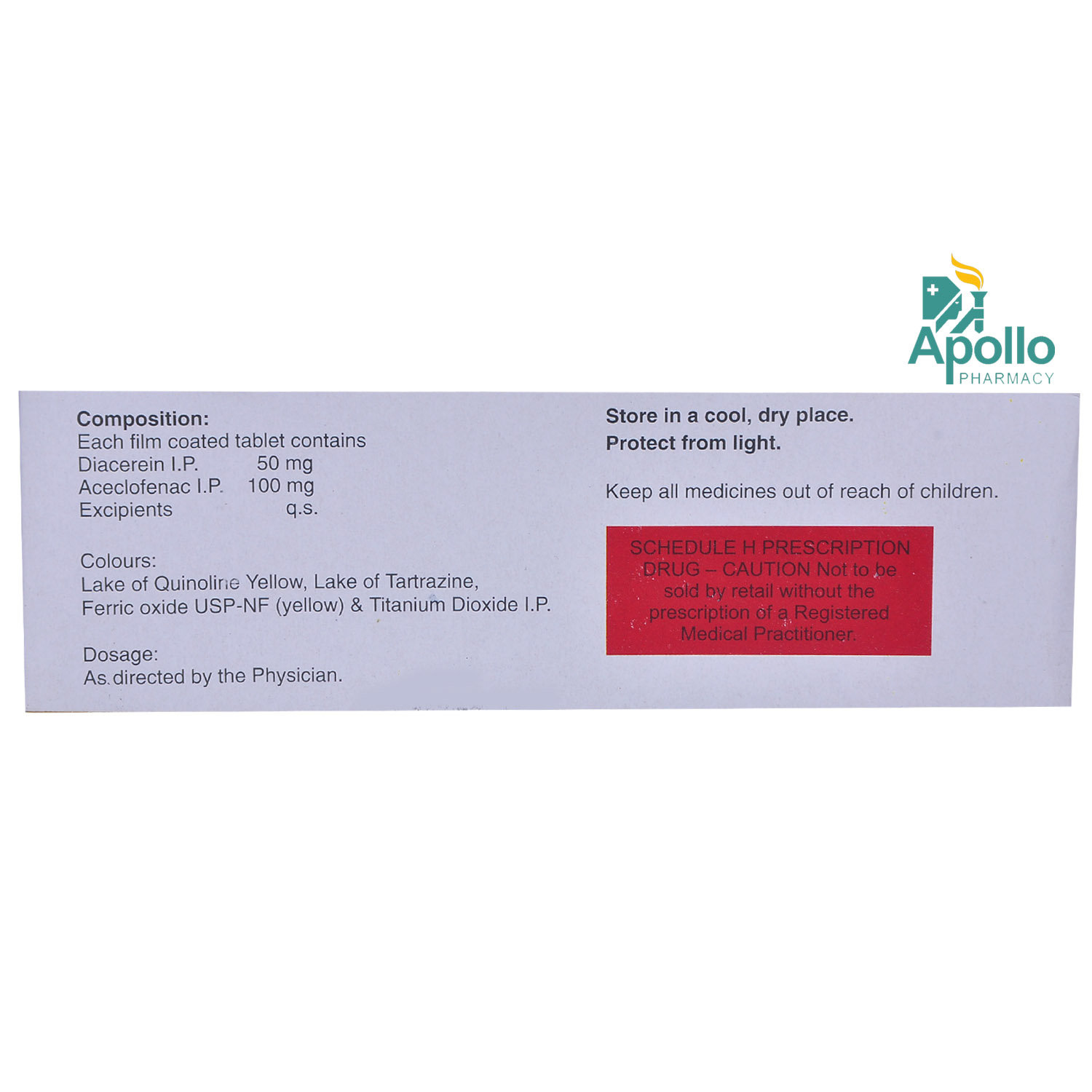
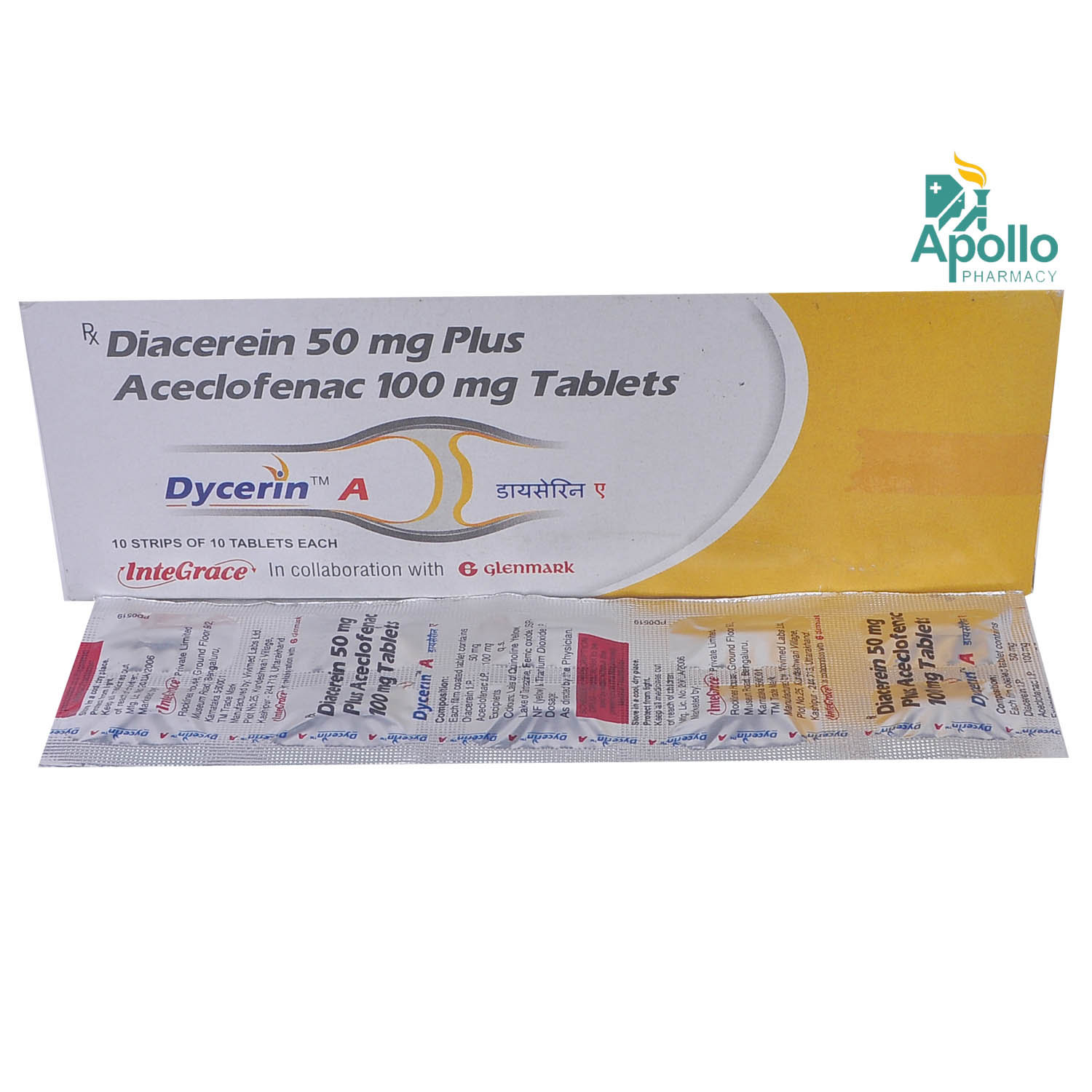
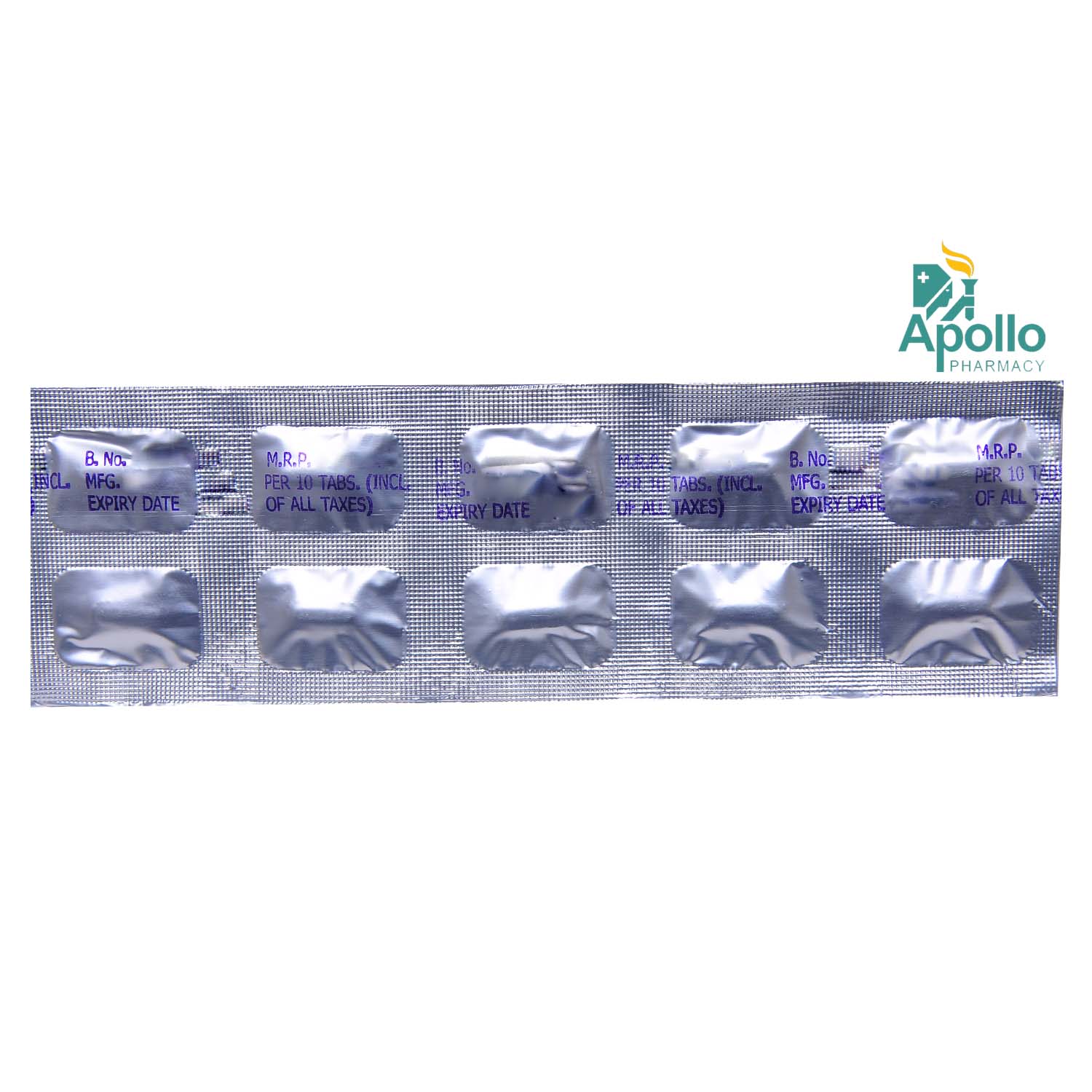
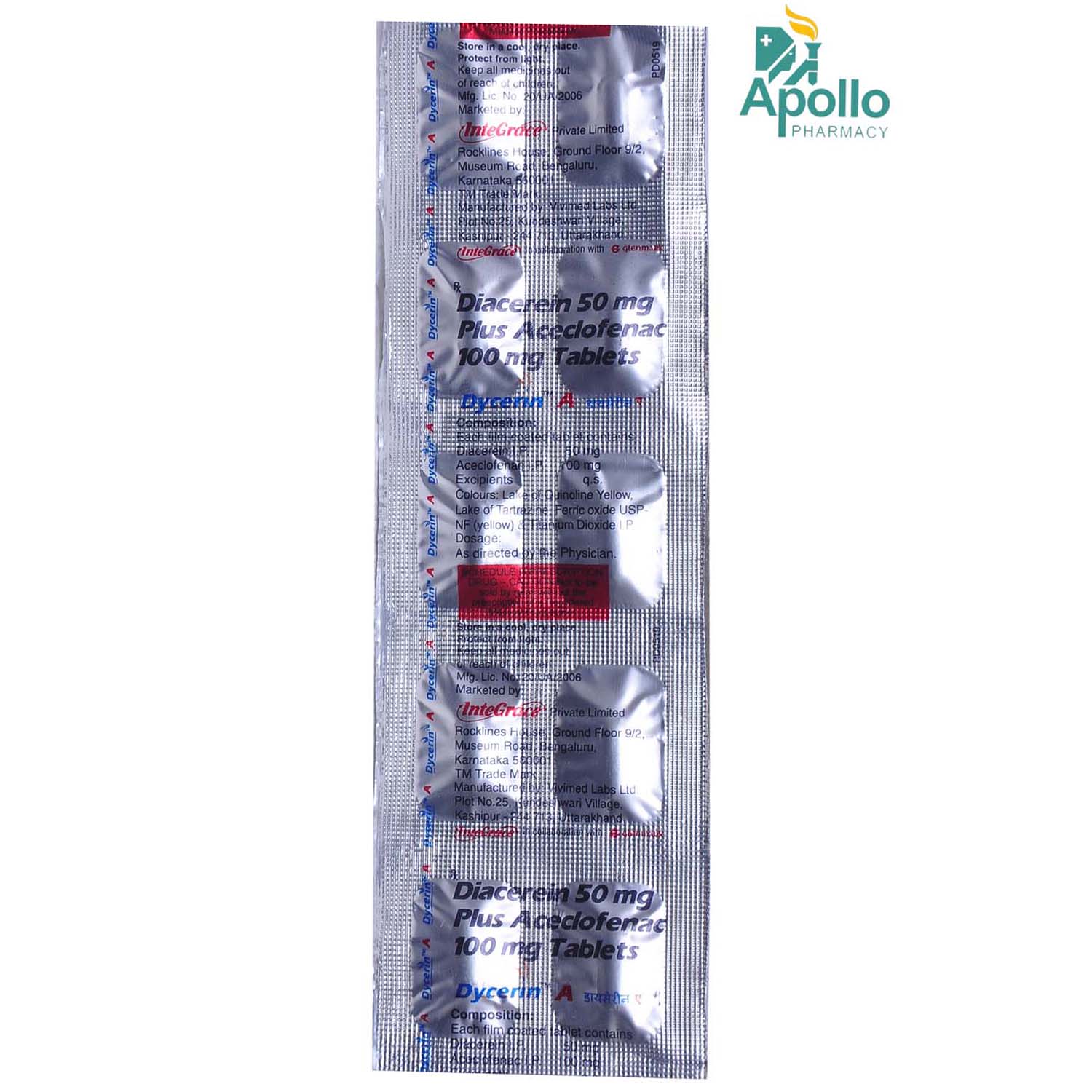





MRP ₹306.5
(Inclusive of all Taxes)
₹46.0 Cashback (15%)
Provide Delivery Location
Online payment accepted
 Prescription drug
Prescription drugWhats That
Composition :
Manufacturer/Marketer :
Consume Type :
Expires on or after :
Return Policy :
About Dycerin A Tablet
Dycerin A Tablet belongs to a group of medicines called Non-Steroidal Anti-Inflammatory Drugs (NSAIDs) used to reduce and relieve pain, redness and inflammation (swelling) in patients suffering from osteoarthritis, rheumatoid arthritis, and ankylosing spondylitis. Osteoarthritis is a disease characterized by the degeneration of cartilage and its underlying bone within a joint, as well as bony overgrowth. Ankylosing spondylitis is a rare type of arthritis that causes pain and stiffness in your spine. Rheumatoid arthritis is an autoimmune disease in which the immune system of the body attacks its own cells and causes damage, thereby causing joint pain with inflammation.
Dycerin A Tablet is composed of two medicines: Aceclofenac and Diacerine. Aceclofenac is a non-steroidal anti-inflammatory drug (NSAID) that works by blocking the release of certain chemical messengers that cause pain and inflammation (redness and swelling). Diacerine works by blocking the actions of a certain specific protein that causes swelling, pain, and degradation of cartilage at bone joints. So this Dycerin A Tablet both in combination reduces pain and inflammation.
Take Dycerin A Tablet as prescribed by the doctor. You can take Dycerin A Tablet with or after food. You are advised to take Dycerin A Tablet for as long as your doctor has prescribed it for you, depending on your medical condition. In some cases, you may experience certain common side effects, such as nausea, vomiting, indigestion, heartburn, stomach pain, diarrhea, loss of appetite, and intense yellow urine. Most of these side effects do not require medical attention and will resolve gradually over time. However, you are advised to talk to your doctor if you experience these side effects persistently.
Do not take Dycerin A Tablet if you are allergic to it. Tell your doctor if you are using any other medicines other than the Dycerin A Tablet . Inform your doctor if you are pregnant/planning to get pregnant/breastfeeding women. Dycerin A Tablet should be used with caution in bleeding disorders, kidney diseases, liver diseases, asthma, people who are in antibiotic therapy, and heart-surgery patients.
Uses of Dycerin A Tablet
Directions for Use
Key Benefits
Dycerin A Tablet is composed of two medicines: Aceclofenac and Diacerine belong to a group of medicines called Non-Steroidal Anti-Inflammatory Drugs (NSAIDs) or pain killers used to reduce and relieve pain, redness, and inflammation (swelling) in patients suffering from osteoarthritis, rheumatoid arthritis and ankylosing spondylitis. Aceclofenac is a non-steroidal anti-inflammatory drug (NSAID) that works by blocking the release of certain chemical messengers that cause pain and inflammation (redness and swelling). Diacerine works by blocking the actions of a certain specific protein that causes swelling, and pain, and reduces friction in the joints by the building of cartilage (the soft connective tissue in the bones near the joints).
Storage
- Inform your doctor about dizziness symptoms. They may adjust your medication regimen or prescribe additional medications to manage symptoms.
- Follow your doctor's instructions for taking medication, and take it at the same time every day to minimize dizziness.
- When standing up, do so slowly and carefully to avoid sudden dizziness.
- Avoid making sudden movements, such as turning or bending quickly, which can exacerbate dizziness.
- Drink plenty of water throughout the day to stay hydrated and help alleviate dizziness symptoms.
- If you're feeling dizzy, sit or lie down and rest until the dizziness passes.
- Track when dizziness occurs and any factors that may trigger it, and share this information with your doctor to help manage symptoms.
- Take medications with food (if recommended): It can help prevent stomach distress and indigestion.
- Eat smaller, more frequent meals: Divide daily food intake into smaller, more frequent meals to ease digestion.
- Avoid trigger foods: Identify and avoid foods that trigger indigestion, such as spicy, fatty, or acidic foods.
- Stay upright after eating: Sit or stand upright for at least 1-2 hours after eating to prevent stomach acid from flowing into the oesophagus.
- Avoid carbonated drinks: Avoid drinking carbonated beverages, such as soda or beer, which can worsen indigestion.
- Manage stress: To alleviate indigestion, engage in stress-reducing activities like deep breathing exercises or meditation.
- Consult a doctor if needed: If indigestion worsens or persists, consult a healthcare professional to adjust the medication regimen or explore alternative treatments.
- Apply a hot/cold pack to the affected area.
- Doing gentle exercises can help cope with pain by stretching muscles.
- Get enough sleep. It helps enhance mood and lower pain sensitivity.
- Avoid alcohol, smoking and tobacco as they can increase pain.
- Follow a well-balanced meal.
- Meditation and massages may also help with pain.
- Inform your doctor about the nausea and discuss possible alternatives to the medication or adjustments to the dosage.
- Divide your daily food intake into smaller, more frequent meals to reduce nausea.
- Opt for bland, easily digestible foods like crackers, toast, plain rice, bananas, and applesauce.
- Avoid certain foods that can trigger nausea, such as fatty, greasy, spicy, and smelly foods.
- Drink plenty of fluids, such as water, clear broth, or electrolyte-rich beverages like coconut water or sports drinks.
- Use ginger (tea, ale, or candies) to help relieve nausea.
- Get adequate rest and also avoid strenuous activities that can worsen nausea.
- Talk to your doctor about taking anti-nausea medication if your nausea is severe.
- Record when your nausea occurs, what triggers it, and what provides relief to help you identify patterns and manage your symptoms more effectively.
Drug Warnings
Do not take Dycerin A Tablet if you are allergic to it. Tell your doctor if you are using any other medicines other than the Dycerin A Tablet . Inform your doctor if you are pregnant/planning to get pregnant/breastfeeding women. Dycerin A Tablet should be used with caution in bleeding disorders, kidney diseases, liver diseases, asthma, and heart-surgery patients. Dycerin A Tablet should be used with caution in patients having irritable bowel or other associated conditions of the gastrointestinal tract due to an increase in the risk of adverse effects. Avoid consuming alcohol while taking Dycerin A Tablet as it can increase your risk of stomach problems. Your doctor may regularly monitor your kidney function, liver function, blood sugar level, and levels of blood components if you are taking this Dycerin A Tablet for long-term treatment. Dycerin A Tablet should not be taken with antibiotics since the risk of gastric irritation and persistent diarrhea is significantly more.
Drug-Drug Interactions
Drug-Drug Interactions
Login/Sign Up
Co-administration of Atenolol with Dycerin A Tablet could increase the risk of low blood pressure.
How to manage the interaction:
Although there is a possible interaction between Atenolol and Dycerin A Tablet, you can take these medicines together if prescribed by a doctor. Consult a doctor if you experience excessive sweating, shortness of breath, palpitations, or chest discomfort. Do not discontinue any medications without consulting a doctor.
Drug-Food Interactions
Drug-Food Interactions
Login/Sign Up
Diet & Lifestyle Advise
-
Physical activity helps strengthen muscles and relieves joint stiffness. Gentle activities like 20-30minutes of walking or swimming would be helpful.
-
Performing yoga may also help in improving joint flexibility and pain management.
-
Maintain a healthy weight by performing regular low-strain exercises and eating healthy food.
-
Get adequate sleep, as resting the muscles can help reduce inflammation and swelling.
-
Follow heat or cold therapy, and apply a cold or hot compress on the joints for 15-20minutes regularly.
-
De-stress yourself by meditating, reading books, taking a warm bubble bath or listening to soothing music.
-
Acupuncture, massage and physical therapy may also be helpful.
-
Eat food rich in antioxidants such as berries, spinach, kidney beans, dark chocolate, etc.
-
Foods containing flavonoids help in reducing inflammation. These include soy, berries, broccoli, grapes and green tea.
-
Avoid smoking and alcohol consumption.
Side Effects of Dycerin A Tablet
- Nausea
- Vomiting
- Indigestion
- Heartburn
- Stomach pain
- Diarrhea
- Loss of appetite
- Intense yellow urine
Habit Forming
Therapeutic Class
All Substitutes & Brand Comparisons
RX
Out of StockDiatril Ace 100mg/50mg Tablet
Werke Healthcare
₹78
(₹7.02 per unit)
74% CHEAPERRX
Out of StockDica Tablet
Lark Laboratories
₹94.28
(₹8.49 per unit)
69% CHEAPERRX
Out of StockDizi-A 100mg/50mg Tablet
₹99
(₹8.91 per unit)
67% CHEAPER
Product Substitutes
Drug-Diseases Interactions
Drug-Diseases Interactions
Login/Sign Up
FAQs
Dycerin A Tablet is composed of two medicines: Aceclofenac and Diacerine. Aceclofenac is a non-steroidal anti-inflammatory drug (NSAID) that works by blocking the release of certain chemical messengers that cause pain and inflammation (redness and swelling). Diacerine works by blocking the actions of a certain specific protein that causes swelling, and pain and reduces friction in the joints by the building of cartilage (the soft connective tissue in the bones near the joints) in the joints.
Dycerin A Tablet may cause common side effects like nausea, vomiting, indigestion, heartburn, stomach pain, diarrhea, loss of appetite, and intense yellow urine. Most of these side effects do not require medical attention and will resolve gradually over time. However, you are advised to talk to your doctor if you experience these side effects persistently.
No, Dycerin A Tablet does not cure Rheumatoid arthritis, but instead, it helps in reducing the pain and inflammation caused by it as it is a pain killer.
No, do not stop taking Dycerin A Tablet suddenly. If you want to stop taking this medicine, consult your doctor so that he/she might gradually reduce the dose to avoid an unwanted increase in pain or inflammation.
No, Dycerin A Tablet should ideally not be taken for stomach pain without consulting a physician. This medication can increase the secretion of stomach acid, which may worsen gastritis or an unknown underlying stomach ulcer.
Drug-Drug Interactions Checker List
- LITHIUM
- DIGOXIN
- AMOXICILLIN
- ALUMINIUM HYDROXIDE
- PREDNISONE
- ENALAPRIL
- LISINOPRIL
- CANDESARTAN
- HYDRALAZINE
- WARFARIN
Special Advise
-
The components of Dycerin A Tablet have the tendency to cause stomach upset. Thus, it is recommended to consume Dycerin A Tablet with meals to minimize gastric side effects. If you have a diagnosis of peptic ulcer, Dycerin A Tablet is best avoided unless prescribed by your doctor.
-
Avoid consuming alcohol while Dycerin A Tablet as it can increase your risk of stomach problems.
Disease/Condition Glossary
Osteoarthritis: It is a degenerative joint disease in which the breakdown of a cartilage protective covering causes the two ends of the joints to come together. The lack of this protective covering causes the joints to rub against one another, causing discomfort and stiffness. Osteoarthritis signs and symptoms include pain, stiffness, swelling, and tenderness. Age is the primary cause of osteoarthritis. Osteoarthritis, also referred to as a degenerative disease because it causes the joints to wear out as a person ages, is more likely to develop as you get older. Past injuries like torn ligaments, dislocated joints, and torn cartilage are additional causes.
Rheumatoid arthritis: Joint pain and damage are caused by an auto-immune disease in which the immune system of the body attacks its own tissue. Rheumatoid arthritis symptoms include joint pain, stiffness, swelling, deformities, and loss of joint function.
Ankylosing spondylitis: The spine becomes painful and stiff as a result. The lower back is where the pain typically first appears, but it can also affect the neck, damaged joints, or other areas of the body. Reduced flexibility, which typically causes a hunched-forward posture, and pain in the back and joints are all signs of ankylosing spondylitis.

Have a query?
Buy best C.n.s Drugs products by
Intas Pharmaceuticals Ltd
Sun Pharmaceutical Industries Ltd
Torrent Pharmaceuticals Ltd
Alkem Laboratories Ltd
Abbott India Ltd
Cipla Ltd
Alteus Biogenics Pvt Ltd
Micro Labs Ltd
Lupin Ltd
Ipca Laboratories Ltd
D D Pharmaceuticals Pvt Ltd
Icon Life Sciences
Mankind Pharma Pvt Ltd
Tripada Healthcare Pvt Ltd
Arinna Lifesciences Ltd
Linux Laboratories Pvt Ltd
East West Pharma India Pvt Ltd
La Renon Healthcare Pvt Ltd
Talent India Pvt Ltd
Tas Med India Pvt Ltd
Zydus Healthcare Ltd
Cnx Health Care Pvt Ltd
Eris Life Sciences Ltd
Leeford Healthcare Ltd
Emcure Pharmaceuticals Ltd
Macleods Pharmaceuticals Ltd
Sigmund Promedica
Aristo Pharmaceuticals Pvt Ltd
Dr Reddy's Laboratories Ltd
Troikaa Pharmaceuticals Ltd
Consern Pharma Ltd
Zydus Cadila
Shine Pharmaceuticals Ltd
Wockhardt Ltd
Ardent Life Sciences Pvt Ltd
Crescent Formulations Pvt Ltd
Theo Pharma Pvt Ltd
Reliance Formulation Pvt Ltd
Ikon Pharmaceuticals Pvt Ltd
Propel Healthcare
Neon Laboratories Ltd
Jagsam Pharma
Msn Laboratories Pvt Ltd
Morepen Laboratories Ltd
Pulse Pharmaceuticals
Sanofi India Ltd
Med Manor Organics Pvt Ltd
Hetero Healthcare Pvt Ltd
Novartis India Ltd
Crescent Therapeutics Ltd
Elder Pharmaceuticals Ltd
Solvate Laboratories Pvt Ltd
Akumentis Healthcare Ltd
Mova Pharmaceutical Pvt Ltd
Psyco Remedies Ltd
Tripada Lifecare Pvt Ltd
Ajanta Pharma Ltd
Cyrus Remedies Pvt Ltd
Medishri Healthcare Pvt Ltd
Cadila Healthcare Ltd
Glenmark Pharmaceuticals Ltd
Matteo Health Care Pvt Ltd
Hbc Life Sciences Pvt Ltd
Lyf Healthcare
Matias Healthcare Pvt Ltd
Mesmer Pharmaceuticals
Alembic Pharmaceuticals Ltd
Capital Pharma
Crescent Pharmaceuticals
Medopharm Pvt Ltd
Alniche Life Sciences Pvt Ltd
Kivi Labs Ltd
Talin Remedies Pvt Ltd
USV Pvt Ltd
Quince Lifesciences Pvt Ltd
Solis Pharmaceuticals
Infivis Life Care
Zuventus Healthcare Ltd
Cadila Pharmaceuticals Ltd
Pfizer Ltd
Wallace Pharmaceuticals Pvt Ltd
A N Pharmacia Laboratories Pvt Ltd
Blue Cross Laboratories Pvt Ltd
Jenburkt Pharmaceuticals Ltd
Lia Life Sciences Pvt Ltd
Mano Pharma
Medley Pharmaceuticals Ltd
Primus Remedies Pvt Ltd
FDC Ltd
Maneesh Pharmaceuticals Ltd
Apex Laboratories Pvt Ltd
Gagnant Healthcare Pvt Ltd
Ozone Pharmaceuticals Ltd
RPG Life Sciences Ltd
Strides Shasun Ltd
Unichem International
GlaxoSmithKline Pharmaceuticals Ltd
Kuresys Labs Pvt Ltd
LA Pharma
Trion Pharma India Llp
Alcohol
Safe if prescribed
Consumption of alcohol with Dycerin A Tablet is not recommended during treatment with Dycerin A Tablet due to the increased risk of serious side effects such as severe gastrointestinal bleeding, dizziness, fatigue, weakness, rashes, nausea, joint pain, and fever. So please consult your doctor before taking Dycerin A Tablet , if you have a habit of drinking alcohol.
Pregnancy
Consult your doctor
Dycerin A Tablet use during pregnancy is not recommended unless your doctor believes it is necessary. (It must not be used during the final three months of pregnancy.) Please consult your doctor before using this medicine if you are pregnant or planning a pregnancy.
Breast Feeding
Consult your doctor
Dycerin A Tablet is not recommended for use in breastfeeding as it is not known whether this medicine passes into breast milk. Your doctor may prescribe a safer alternative medicine based on the clinical condition.
Driving
Safe if prescribed
Dycerin A Tablet may decrease alertness, affect your vision or make you sleepy and dizzy. Do not drive if these symptoms occur after taking Dycerin A Tablet .
Liver
Consult your doctor
Dycerin A Tablet should be used with caution in patients with liver disease due to the increased risk of serious side effects. Close monitoring of liver function, appropriate dose adjustments or replacement with alternative medicine may be required based on your clinical condition.
Kidney
Consult your doctor
Dycerin A Tablet should be used with caution in patients with kidney diseases due to the increased risk of serious side effects. Close monitoring of kidney function, appropriate dose adjustments or replacement with alternative medicine may be required based on your clinical condition.
Children
Safe if prescribed
The safety and efficacy of Dycerin A Tablet in children have not been established. Dycerin A Tablet is not recommended for use in children.





